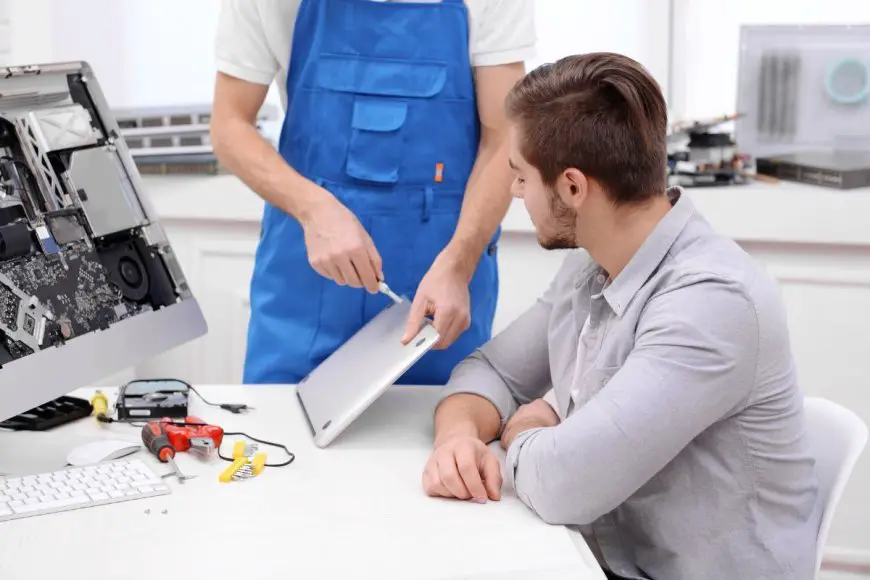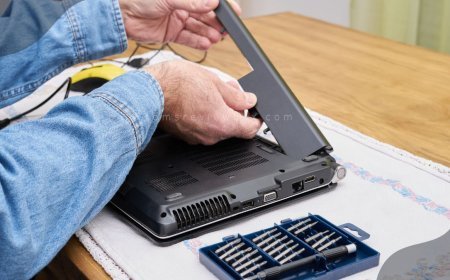How to Fix a Laptop with Water Damage: Quick Solutions
Learn effective solutions to fix a laptop with water damage. Expert tips and step-by-step guides to save your device.

Spillage on your laptop? No need to panic. We've got you covered with simple steps to fix water damage. If the damage is beyond repair, consider a professional repair service or visit a repair shop for warranty coverage. First things first, power off the computer immediately and remove the battery to prevent further damage to the motherboard. Consider seeking professional repair service. Next, unplug any connected devices and remove the power source if possible from the motherboard. Then, turn the laptop upside down to drain excess water, especially if you need liquid damage repairs for the motherboard and have coverage. These quick actions can make all the difference in salvaging your laptop from potential water damage to the motherboard. Stay tuned as we delve into the essential steps for rescuing your laptop from a watery mishap.
Assessing the Damage: How to Determine the Extent of Water Damage
Upon encountering water damage on your laptop, it's crucial to assess the extent of the harm before proceeding with any repair attempts. Let's delve into how you can effectively evaluate the damage and determine its severity.
Visible Signs of Water Damage
Look for visible signs of water, such as wet spots or condensation. These can indicate where the water has seeped into your laptop and help gauge the magnitude of the situation. Inspect for any corrosion or rust on external ports and hinges as these are clear indicators of water exposure.
Functionality Issues
Check for functionality issues like unresponsive keys or a blank screen. If certain keys are sticking or not functioning properly, it could signify internal water damage affecting the keyboard circuitry. A blank screen may indicate a more severe problem within the internal components.
Unusual Sounds
Listen for unusual sounds like sizzling or crackling when attempting to power on your laptop. These noises often suggest that there is a short circuit due to water exposure. It's essential to power off the device immediately if you hear such sounds to prevent further damage.
Assessing the extent of water damage is critical in understanding the risk it poses to your laptop's functionality and longevity. By carefully examining visible signs, functionality issues, and unusual sounds, you can gain insight into how deeply the water has penetrated your device and take appropriate action accordingly.
Removing Excess Liquid: Safely Drying Out a Water-Damaged Laptop
To salvage a water-damaged laptop, it's crucial to remove excess liquid and safely dry the device. Here are essential steps to effectively address this issue.
Use Absorbent Materials
-
Grab dry towels or cloths to gently blot the excess moisture from the laptop's surface.
-
Press down lightly to absorb as much liquid as possible without applying excessive force.
Avoid Heat Sources
-
Refrain from using heat sources such as hairdryers, as they can cause further damage by overheating sensitive components.
-
Heat may lead to the expansion of water inside the laptop, potentially worsening the damage.
Positioning the Laptop
-
Place the laptop in an upside-down position on a flat, dry surface to prevent any remaining liquid from seeping further into the device.
-
This position aids in draining out excess moisture and prevents pooling within the internal components.
Utilize a Dehumidifier
-
Consider placing your laptop near a dehumidifier to help extract residual moisture from within the device.
-
A dehumidifier can aid in accelerating the drying process, especially in humid environments.
Removing Battery (if applicable)
-
If your laptop has a removable battery, carefully detach it following manufacturer guidelines.
-
Removing the battery helps prevent potential short circuits and minimizes electrical damage caused by lingering moisture.
By following these steps, you can effectively manage water damage on your laptop without causing further harm. Always prioritize safety and caution when handling electronic devices exposed to liquids. Remember that swift action is crucial in preventing extensive damage caused by water exposure.
Disassembling the Laptop: Steps to Take for Internal Drying
Refer to Manufacturer Guides or Online Resources
It's essential to refer to the manufacturer's guides or reliable online resources for specific instructions. These resources can provide step-by-step details on how to safely take apart your laptop without causing further damage.
Gently Remove Components
Once you have the necessary guidance, gently remove accessible components such as the RAM, hard drive, and battery. This step is crucial in ensuring that each part can be thoroughly dried and inspected individually.
Allow Components and Internal Parts to Air-Dry Separately
After removing the components, it's important to allow each one and the internal parts of the laptop to air-dry separately. Placing them in a well-ventilated area will aid in accelerating the drying process. Remember not to rush this step; thorough drying is key to preventing potential corrosion or short circuits.
Disassembling a water-damaged laptop requires careful attention and precision. By following manufacturer guidelines or reputable online resources, you can ensure that each component is removed correctly, minimizing the risk of additional damage. Once removed, allowing these components and internal parts to air-dry separately will contribute significantly to restoring your laptop's functionality.
Cleaning and Repairing Components: Restoring Functionality After Water Damage
Using Isopropyl Alcohol and Cotton Swabs
To begin the restoration process, carefully use isopropyl alcohol and cotton swabs to clean any visible corrosion from the circuit boards. Gently dab the affected areas to remove the residue without causing further damage.
Inspecting Connectors and Ports
Inspect all connectors and ports for any residue buildup caused by the water damage. Carefully clean these components using isopropyl alcohol or a specialized electronic cleaner to ensure they are free from any remaining contaminants.
Replacing Damaged Components if Necessary
If certain internal components have been irreversibly damaged by the water, it may be necessary to replace them with new parts. This could involve replacing corroded circuit boards, damaged connectors, or other essential elements that have been compromised.
Importance of Professional Repair Service
Consider seeking professional repair services if you are unsure about your ability to effectively clean and repair the laptop after water damage. A professional technician can provide comprehensive cleaning and repair, ensuring all affected components are properly restored.
Microfiber Cloth for Drying Internal Components
After cleaning, use a microfiber cloth to gently dry the internal components of the laptop. Ensure that each component is thoroughly dried before reassembling the device to prevent further damage or corrosion.
Insurance Coverage for Water Damage Repairs
Check whether your insurance policy provides coverage for water damage repairs. Some policies may include support for repairing electronic devices that have been damaged by water, potentially alleviating some of the financial burden associated with repairs.
Powering On After Repairs
Once all necessary repairs have been completed, cautiously power on the laptop to test its functionality. Listen for any irregular sounds or observe unusual behavior that may indicate lingering issues stemming from the water damage.
Reassembling and Testing: Ensuring the Laptop Works Properly After Repair
Carefully Reassemble All Components Following Disassembly Steps in Reverse Order
After cleaning and repairing the components, it's crucial to reassemble them meticulously. Start by referring back to the disassembly steps and work in reverse order to ensure everything is put back together correctly.
Power On the Laptop and Check Each Function Including Keyboard, Touchpad, and Display
Once reassembled, power on the laptop and thoroughly check each function. Test the keyboard by typing on it, ensure the touchpad responds accurately, and verify that there are no issues with the display.
Run Diagnostic Tests or Software Tools to Ensure All Hardware Is Functioning Properly
To guarantee that all hardware components are functioning as they should, run diagnostic tests or use software tools designed for this purpose. These tests can help identify any underlying issues that may not be immediately apparent during a visual inspection.
Tips for Saving a Laptop from Liquid Damage
Silica Gel Packets
Keep silica gel packets in your laptop bag. These little packets can be a lifesaver, as they are excellent at absorbing moisture in case of spills.
Spill-Resistant Accessories
Consider investing in spill-resistant keyboard covers or protective cases for your laptop. These accessories act as an additional layer of protection, reducing the risk of liquid seeping into the internal components.
Regular Data Backup
Backup important data regularly to an external storage device or cloud service. This precaution ensures that even if your laptop sustains liquid damage, your crucial files and documents remain safe and easily recoverable.
Laptops are prone to accidental spills, and protecting them from liquid damage is crucial for their longevity. Silica gel packets are a simple yet effective solution to absorb any moisture that may find its way into your laptop during an unexpected spill. By keeping these packets in your laptop bag, you create a safeguard against potential water damage without any hassle.
Investing in spill-resistant keyboard covers or protective cases is another proactive step to shield your laptop from liquid mishaps. These accessories act as a barrier, minimizing the chances of liquids reaching the sensitive internal components of your device. While this may require some initial investment, it can potentially save you from costly repairs or even having to replace the entire laptop due to irreparable water damage.
Regularly backing up important data is not only a good practice for general data security but also serves as a safety net in case of liquid-related incidents. By maintaining updated backups on an external hard drive or using cloud storage services, you ensure that critical files such as work documents, personal photos, and other valuable data are not lost if your laptop encounters water damage beyond repair.
Incorporating these tips into your routine can significantly reduce the risk posed by liquid exposure to your laptop while providing peace of mind knowing that you have taken proactive measures to safeguard your valuable device.
Successfully Fixing a Laptop with Water Damage
You've made it through the essential steps of rescuing your water-damaged laptop, and now it's time to put everything back together. Remember, patience is key in this process. Take your time and ensure each component is thoroughly dry before reassembling. Once you've completed the reassembly, it's crucial to test every function of your laptop meticulously. Just like piecing together a jigsaw puzzle, every part must fit snugly for the whole picture to come together. If all goes well, you'll have revived your once waterlogged laptop into a fully functioning device again.
Now that you've armed yourself with the knowledge of salvaging a water-damaged laptop, don't hesitate to share these tips with others who might find themselves in a similar predicament. Prevention is always better than cure; consider investing in spill-resistant accessories or keeping liquids far away from your electronic companions.
FAQs
Can I use rice to dry out my water-damaged laptop?
Rice can help absorb moisture but may leave behind residue that could further damage internal components. It's best to use professional drying techniques or materials designed specifically for electronics.
How long should I wait before attempting to turn on my laptop after water damage?
It's recommended to wait at least 48 hours before attempting to power on your laptop after exposure to water. Rushing the process could lead to irreversible damage.
Is it worth repairing a water-damaged laptop, or should I consider buying a new one?
The decision depends on the extent of the damage and the cost of repairs compared to purchasing a new device. Consulting with a professional technician can provide insight into whether repair is feasible.
What's Your Reaction?







































![MacBook Pro M5: All the features and specs you need to know [LEAKS REVEALED]](https://tomsreviewbox.com/uploads/images/202502/image_430x256_67bd6d7cd7562.jpg)



























